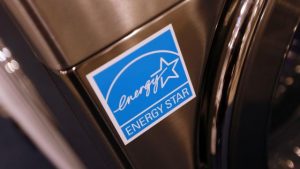ENERGY STAR® is the government-backed symbol for energy efficiency, providing simple, credible, and unbiased information that consumers and businesses rely on to make well-informed decisions.
Thousands of industrial, commercial, utility, state, and local organizations—including more than 40 percent of the Fortune 500®—rely on their partnership with the U.S. Environmental Protection Agency (EPA) to deliver cost-saving energy efficiency solutions.
Ninety-percent of American households recognize the ENERGY STAR, making it one of the most widely recognized consumer symbols in the nation. Together, since 1992, ENERGY STAR and its partners have helped save American families and businesses more than $450 billion and over 3.5 trillion kilowatt-hours of electricity while also achieving broad emissions reductions—all through voluntary action.
ENERGY STAR for businesses and organizations
ENERGY STAR tools and resources help businesses determine cost-effective approaches to managing energy use in their buildings and plants—enabling the private sector to save energy, increase profits, and strengthen their competitiveness. From commercial properties such as hospitals, schools, and offices, to industrial facilities such as cookie and cracker bakeries and integrated steel mills, thousands of businesses and organizations look to ENERGY STAR for guidance on strategic energy management.
The program’s popular online tool, ENERGY STAR Portfolio Manager®, has been used to measure and track the energy performance of hundreds of thousands of commercial buildings across the nation. For eligible buildings, the tool calculates a 1–100 ENERGY STAR score, which has become the industry standard for rating a facility’s energy performance. Studies find that ENERGY STAR certified buildings command a premium of up to 16 percent for sales prices and rental rates.3 Learn more about ENERGY STAR for commercial buildings and industrial plants.
ENERGY STAR is the simple choice for energy efficiency, making it easy for consumers and businesses to purchase products that save them money and protect the environment. EPA ensures that each product that earns the label is independently certified to deliver the quality, performance, and savings that consumers have come to expect. It’s that integrity that led Americans to purchase more than 300 million ENERGY STAR certified products in 2016, with a market value of more than $100 billion. In fact, an average of $800,000 ENERGY STAR certified products were sold every day in 2016, bringing the total to more than 5.8 billion products sold since 1992. Learn more about ENERGY STAR products.
About ENERGY STAR for Industrial Plants
American manufacturers have embraced ENERGY STAR as a means to build successful energy programs, engage in vibrant peer networks, and improve their facilities’ energy performance. EPA currently works with 31 industrial sectors to foster collaboration and develop industry-specific tools and resources. These sectors span the U.S. economy—from cookie and cracker bakeries and pharmaceutical plants to integrated steel mills and petroleum refineries.
Plants achieve ENERGY STAR certification and reductions
Popular tools include energy performance indicators, which provide companies with the information they need to make smart investment decisions. ENERGY STAR provides industry-specific energy performance indicators for 17 different types of manufacturing plants, and 93 plants earned the ENERGY STAR for superior energy performance in 2017.
In addition, 38 industrial plants achieved energy use intensity reductions in the 2017 ENERGY STAR Challenge for Industry campaign, in which industrial sites commit to reducing their energy intensity by 10 percent within five years.
Program savings
Together, the ENERGY STAR program for industrial plants helped businesses save $1.4 billion in energy costs in 2016, contributing to cumulative energy cost savings of $42 billion since 1992.
About ENERGY STAR for Commercial Buildings
Businesses embrace ENERGY STAR for the same reasons that consumers do: it’s a widely recognized symbol of energy efficiency, translating technical details into simple, credible, and actionable information. ENERGY STAR tools and resources help businesses determine the most cost-effective approach to managing energy use in their buildings and plants—enabling the private sector to save energy, increase profits, and strengthen their competitiveness. Thousands of diverse organizations across the nation—from Fortune 100® companies and major league sports teams to school districts and small businesses—have partnered with EPA to improve their facilities’ energy performance
Portfolio Manager and the 1 – 100 ENERGY STAR Score
Commercial buildings have embraced EPA’s energy measurement and tracking tool, ENERGY STAR Portfolio Manager. In fact, hundreds of thousands of commercial properties use ENERGY STAR Portfolio Manager to measure and track their energy performance. Owners of commercial buildings and industrial plants have also adopted EPA’s 1 – 100 ENERGY STAR score as the industry standard for measuring energy performance. Learn more.
The value of ENERGY STAR certification for buildings
In 2017, more than 9,500 commercial buildings earned the ENERGY STAR, bringing the total to more than 32,000. Buildings that earn the ENERGY STAR use, on average, 35 percent less energy than their peers. For commercial real estate, ENERGY STAR is a market differentiator. Studies find that ENERGY STAR certified buildings command a premium of up to 16 percent for sales prices and rental rates.1 Real estate companies use EPA’s 1 – 100 ENERGY STAR score to demonstrate their sustainability to investors through reporting frameworks such as the Global Real Estate Sustainability Benchmark (GRESB) and the Sustainability Accounting Standards Board (SASB) and multifamily property owners use it to access discounted financing through products offered by Fannie Mae, Freddie Mac, and the U.S. Department of Housing and Urban Development.
ENERGY STAR as a resource
Businesses and organizations also rely on ENERGY STAR as their trusted resource for practical information on saving energy. In 2017, American consumers and businesses visited the ENERGY STAR website more than 7.5 million times to learn how to reduce their energy costs, making use of popular tools such as ENERGY STAR Portfolio Manager®, the ENERGY STAR Home Advisor, and the Home Energy Yardstick.
Program savings
Together, the ENERGY STAR program for commercial buildings helped businesses and organizations save $10 billion in energy costs in 2016, contributing to cumulative energy cost savings of $150 billion since 1992.2
Spotlight on: State and local benchmarking initiatives
As of the end of 2017, 26 local governments and two states rely on EPA’s ENERGY STAR Portfolio Manager tool as the foundation for their building energy benchmarking requirements, creating uniformity for businesses and reducing transaction and implementation costs. Combined, these requirements apply to approximately 100,000 buildings, representing more than 10.8 billion square feet.
Additional local governments and states have required ENERGY STAR Portfolio Manager in the benchmarking of their own facilities. Learn more.
ENERGY STAR for homes
New homes can also earn the ENERGY STAR, meaning they are at least 15% more efficient than those built to code and include additional energy-saving features to deliver a performance advantage of up to 30% compared to typical new homes. And homebuyers have more energy-efficient homes to choose from than ever before: Nearly ninety percent of the nation’s largest homebuilders build ENERGY STAR Certified New Homes, helping to bring the total to more than 1.9 million homes built as of 2017. Additionally, in 2017, 91,000 homeowners retrofitted their existing homes for improved energy efficiency through the Home Performance with ENERGY STAR program. Learn more about ENERGY STAR for homes.
Utilities and local governments rely on ENERGY STAR
Nationwide, utilities invested $7.7 billion in energy efficiency programs in 2015. With hundreds of disparate utilities scattered around the country, EPA plays a critical unifying role to guide their energy efficiency programs. EPA enables utilities to leverage ENERGY STAR as a common national platform, avoiding the creation of hundreds of independent utility programs across the nation, which could fragment the market and stall innovation. More than 700 utility, state and local governments, and nonprofits leverage ENERGY STAR in their efficiency programs, reaching roughly 95% of households in all 50 states.
Additionally, as of the end of 2017, 26 local governments and two states rely on EPA’s ENERGY STAR Portfolio Manager® tool as the foundation for their energy benchmarking and transparency policies, creating uniformity for businesses and reducing transaction and implementation costs.
ENERGY STAR and the economy
ENERGY STAR fosters economic development, greater competitiveness, and a healthy environment. ENERGY STAR certified products, homes, buildings, and plants helped save Americans families and businesses nearly 400 billion kWh of electricity and over $30 billion on their energy costs in 2016 alone. Moreover, by increasing energy efficiency, ENERGY STAR is supporting U.S. energy security and helping improve the reliability of the electricity grid.
Additionally, according to the U.S. Energy and Employment Report for 2016, 290,000 American workers are involved in the manufacture of ENERGY STAR certified products and building materials. The report also projects that employment in energy efficiency will grow much faster than other areas of the energy sector—9 percent in 2017 vs. average projected growth of 5 percent across the entire energy sector—and ENERGY STAR is an integral part of that market.
ENERGY STAR and the environment
ENERGY STAR contributes to improved environmental quality and public health. Through voluntary action, ENERGY STAR provides states and local governments with more flexibility and reduced costs towards meeting their air quality requirements and their health and environmental goals. In 2016 alone, ENERGY STAR helped Americans save approximately 400 billion kWh of electricity with associated emission reductions of 320 million metric tons of greenhouse gas emissions, 300,000 short tons of sulfur dioxide, 220,000 short tons of nitrogen oxides, and 23,000 short tons of fine particulate matter (PM2.5). Since 1992, ENERGY STAR associated greenhouse gas reductions have reached 3.1 billion metric tons.
_________________________________________________
ENERGY STAR® is the government-backed symbol for energy efficiency.

















